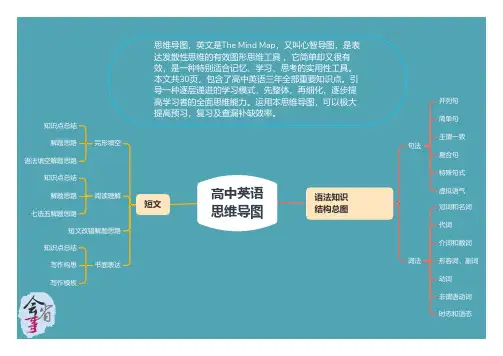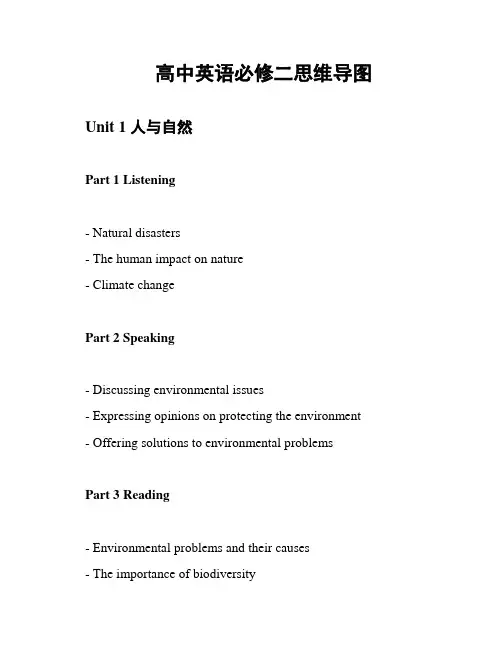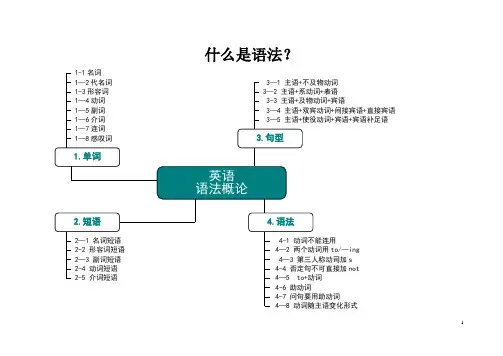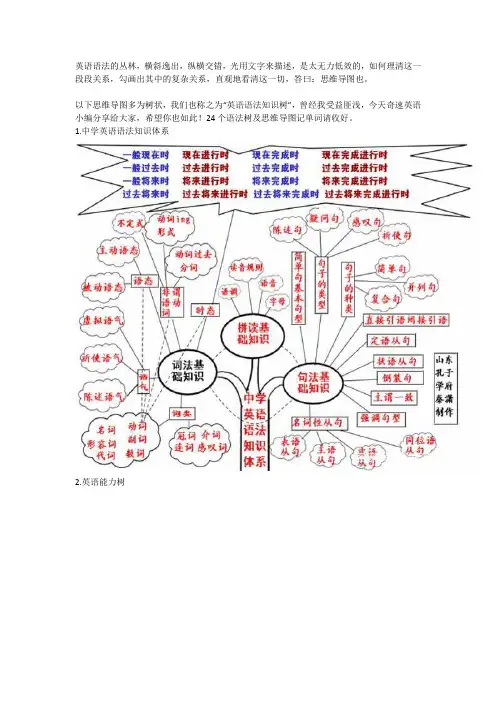高中英语思维导图
- 格式:docx
- 大小:8.59 MB
- 文档页数:51


高中英语必修二思维导图Unit 1 人与自然Part 1 Listening- Natural disasters- The human impact on nature- Climate changePart 2 Speaking- Discussing environmental issues- Expressing opinions on protecting the environment - Offering solutions to environmental problemsPart 3 Reading- Environmental problems and their causes- The importance of biodiversity- Ways to preserve the natural environmentPart 4 Writing- Describing the impact of human activities on the environment - Writing an argumentative essay on environmental protection - Suggesting measures to reduce pollution and promote sustainabilityUnit 2课文导读Part 1 Listening- Understanding the main ideas of the text- Identifying supporting details- Discussing the author's point of viewPart 2 Speaking- Discussing the themes and characters in the text- Analyzing the text's structure and language use- Relating the text to personal experiences or similar literary works Part 3 Reading- Analyzing the text's writing style and literary devices- Interpreting the text's underlying themes and messagesPart 4 Writing- Writing a summary of the text- Writing a character analysis- Reflecting on the text's themes and their relevance in modern societyUnit 3中的教室思维导图Part 1 Listening- Classroom activities and routines- Group dynamics and collaboration- Effective learning strategiesPart 2 Speaking- Discussing classroom rules and etiquette- Expressing opinions on different teaching methods- Reflecting on the importance of individual effort and cooperation Part 3 Reading- Understanding different learning styles- Problem-solving techniques- Critical thinking and decision-making skillsPart 4 Writing- Describing a memorable classroom experience- Writing a persuasive essay on the benefits of group work- Reflecting on personal learning strategies and setting goals for improvementUnit 4课文导读Part 1 Listening- Understanding the main ideas of the text- Identifying literary devices and figurative language- Discussing the author's purpose and messagePart 2 Speaking- Analyzing the characters and their relationships in the text- Exploring the text's themes and symbolsPart 3 Reading- Analyzing the text's structure and narrative techniques- Interpreting the text's cultural and historical contextPart 4 Writing- Exploring the text's themes and their relevance in society - Analyzing the author's use of language and style。

什么是语法?+表语+宾语+间接宾语+直接宾语+宾语+宾语补足语to/—ingsnot一般现在时vs.一般过去时一般将来时将来时表示将来某个时间要发生的动作或存在的状态,也表示将来经常或者重复发生的动作,常与表示将来的时间副词连用,例如:soon,next week, this afternoon,tomorrowWe will graduate next year.我们明年毕业。
进行时(1)(V+ing)现在分词(V+ing)现在分词(V+ing)?进行时(2)完成时(1)Part1 完成时的句型构成1-1 陈述句型:S+has/have+过去分词(p。
p。
)I have already finished my homework.(我已经完成了我的作业)1-2 否定句型:S+has/have+not+过去分词(p。
p.)Sandy has been a nurse in this hospital for 15 years。
(珊蒂已经在这家医院担任护士长达15年了。
)1-3 疑问句型:Has/Have+s+过去分词(p。
p。
)?Have you ever seen Peter in past 3 months?(过去3个月内,你看见过彼吗?)2-1 陈述句型:S+had+过去分词(p。
p。
)This proposal had been deliverde by Eva before Aaron finished it。
(这个计划在艾伦完成以前,伊娃就已经提交出去了)2-2 否定句型:S+had+not+过去分词(p。
p。
)I had not finished my work when he visited me last week.(上周他来拜访我以前,我还没有完成工作。
)2-3 疑问句型:Had+s+过去分词(p。
p.)?Had you ever been to a blind date before you married?(你结婚以前曾经参加相亲吗?)3-1 陈述句型:S+shall/will+have+过去分词(p。

英语语法的丛林,横斜逸出,纵横交错,光用文字来描述,是太无力低效的,如何理清这一段段关系,勾画出其中的复杂关系,直观地看清这一切,答曰:思维导图也。
以下思维导图多为树状,我们也称之为“英语语法知识树”,曾经我受益匪浅,今天奇速英语小编分享给大家,希望你也如此!24个语法树及思维导图记单词请收好。
1.中学英语语法知识体系
2.英语能力树
3. 英语学习习惯
4. 单词记忆通用工具
5. 英语整体建构课堂教学模式
6. “和谐教育整体建构教学法”
7. 中学英语16种时态
8. 名词I
9. 名词II
10. 冠词
11. 数词
12. 代词的分类
13. 人称代词
14. 物主代词
15. 反身代词
16.指示代词
17. 疑问代词
18. 关系代词
19.不定代词
20. 形容词
21. 副词
22.形容词和副词的比较等级
23. 有关比较级的区别
24. 动词。
